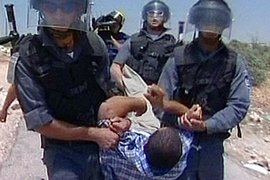Veterans of the barrier protest
West Bank villagers have a clear message for Israel: Give us back our land.

 |
| Hundreds have been arrested during the Bil’in protests over the last two years |
The turnout and the tactics vary, but for over 20 months the village of Bil’in in the West Bank has been holding weekly demonstrations on the same theme.
A few kilometres west of Ramallah, this small village has lost almost 60 per cent of its land to the Israeli separation barrier.
And every week, the same chant – “No to the wall!” – makes it clear that Bil’in wants its land back.
That demand has put Bil’in – which has a population of only 1,600 – at the centre of Palestinian resistance to the building of the separation barrier.
Protest campaign
The barrier, concrete in some areas and wire fencing in others, is opposed because of the view that it is a land-grab mechanism, although Israeli authorities say it is a security measure.
More than half of the barrier has been completed and, if it runs according to the proposed path, it will lie east of the ceasefire line of 1967, the so-called Green Line, for 80 per cent of its length.
|
Facts – The barrier will be 670km (420 miles) long when complete – Will leave about 10.1 per cent of West Bank on “Israeli side”, home to 50,000 Palestinians
– In July 2004, the International Court of Justice said the barrier was illegal under international law |
Every week, anywhere between 50 and 500 demonstrators gather in Bil’in after Friday prayers, and march over to the patrolled wire fence marking the new village boundary.
There are creative spins to the protests – demonstrators have chained themselves to trees, to the fence, turned up as a funeral procession or secured themselves inside cages.
Before the barrier was built, attempts were made to stop it; now there are efforts to dismantle parts of it.
As a result, the village is a regular news item in Israel and beyond.
Defining the village’s grassroots campaign, Mohammed Khatib of the Bil’in Popular Committee Against the Wall says: “We think a solution will come from the people, not the leaders.”
Rubber bullets
But the notoriety has come at a cost.
The campaigners describe themselves as peaceful and espouse the non-violent methods of Mandela and Gandhi, but are routinely dispersed with tear gas, stun grenades, rubber bullets and batons.
Israeli security officials have said that riot dispersal methods are used only to counter stones thrown by demonstrators or attempts to breach the fence.
“During these 20 months, 600 people from the village have been injured, some of them four or five times,” says Abedallah Abu Rahma, another committee member.
About 50 villagers have been arrested, and Abu Rahma, has been arrested three times.
Israeli involvement
The publicity Bil’in attracts is in large part because that Israeli protesters are taking the blows and the arrests alongside the villagers and the other demonstrators from around the world.
 |
| Palestinians say the wall is a deliberate attempt to steal their land |
Israelis have been among those seriously hurt at Bil’in, some sustaining eye and head injuries from rubber bullets.
Khatib says: “When we first started working with them, we didn’t know Israelis except as part of the occupation.
“But now we see them working with us, getting shot with us, and the relationship between us is strong.”
That relationship is “an instrument, not a goal in itself”, according to Kobi Snitz from the Anarchists Against the Wall, the main protagonists from the Israeli side of the campaign.
The priority of many Israeli peace groups is social contact, but for Snitz the focus is on action rather than words – stopping the barrier being built. The Bil’in campaign prefers to “focus on political realities and actual struggle”, he says.
“I don’t think the root of the problem is misunderstanding or cultural difference, or that it would all be OK if only we drank enough tea together,” Snitz says.
He says that thousands of Israelis have attended the Bil’in protest and “been personally transformed by it”.
Legal action
And while Israelis have been to Bil’in, the campaign has also travelled east of the Green Line.
A street-level photographic exhibition in Tel Aviv, an award-winning film, Bil’in Habibti, and a documentary, Enraged, have propelled images of this weekly protest into the Israeli field of vision.
At the same time, the campaign has taken three cases to the Israeli courts, one challenging the path of the barrier around Bil’in, one regarding the Jewish settlement built on the village’s land and the third to do with the declaration of this land as state-owned.
The third case was dismissed recently by the Israeli supreme court; the other two cases have yet to be decided.
The court has decreed a temporary freeze on further construction and occupation of the Matityahu East settlement, where apartment blocks have been built on land Bil’in villagers say is theirs.
Nobody involved in the campaign pretends that all is rosy, but despite the tensions and the toll of this long struggle, protesters say they will continue.
“If we lose our land, we lose our lives, our future,” Abu Rahma says. “We suffer now so that maybe in the future our children will have their land in peace.”
External links:
Hamas storms TV station as deadline looms on Israel deal – Times Online, June 5, 2006